Cost Efficiencies of the Shrimp Fishery in Mexico: A Stochastic Frontier Analysis
Abstract
1. Introduction
2. Materials and Methods
2.1. Study Area
2.2. Theoretical Framework
2.3. Data Description
2.4. Model Specification
3. Results
4. Discussion
5. Conclusions
Supplementary Materials
Author Contributions
Funding
Institutional Review Board Statement
Informed Consent Statement
Data Availability Statement
Acknowledgments
Conflicts of Interest
References
- CONAPESCA. Anuario Estadístico de Acuacultura y Pesca; Comisión Nacional de Pesca: Mazatlán, México, 2019. Available online: https://www.gob.mx/conapesca/documentos/anuario-estadistico-de-acuacultura-y-pesca (accessed on 12 January 2023).
- Aranceta-Garza, F.; Arreguín-Sánchez, F.; Seijo, J.C.; Ponce-Díaz, G.; Lluch-Cota, D.; del Monte-Luna, P. Determination of catchability-at-age for the Mexican Pacific shrimp fishery in the southern Gulf of California. Reg. Stud. Mar. Sci. 2020, 33, 100967. [Google Scholar] [CrossRef]
- CONAPESCA. Anuario Estadístico de Acuacultura y Pesca; Comisión Nacional de Pesca: Mazatlán, México, 2003. Available online: https://www.gob.mx/conapesca/documentos/anuario-estadistico-de-acuacultura-y-pesca (accessed on 12 January 2023).
- CONAPESCA. Anuario Estadístico de Acuacultura y Pesca; Comisión Nacional de Pesca: Mazatlán, México, 2008. Available online: https://www.gob.mx/conapesca/documentos/anuario-estadistico-de-acuacultura-y-pesca (accessed on 12 January 2023).
- CONAPESCA. Anuario Estadístico de Acuacultura y Pesca; Comisión Nacional de Pesca: Mazatlán, México, 2013. Available online: https://www.gob.mx/conapesca/documentos/anuario-estadistico-de-acuacultura-y-pesca (accessed on 12 January 2023).
- CONAPESCA. Anuario Estadístico de Acuacultura y Pesca; Comisión Nacional de Pesca: Mazatlán, México, 2018. Available online: https://www.gob.mx/conapesca/documentos/anuario-estadistico-de-acuacultura-y-pesca (accessed on 12 January 2023).
- Greene, W.H. Fixed and random effects in stochastic frontier models. J. Product. Anal. 2005, 23, 7–32. [Google Scholar] [CrossRef]
- Kumbhakar, S.C.; Lien, G.; Hardaker, B.J. Technical efficiency in competing panel data models: A study of Norwegian farming. J. Product. Anal. 2014, 41, 321–337. [Google Scholar] [CrossRef]
- Aigner, D.; Lovell, C.A.K.; Schmidt, P. Formulation and estimation of stochastic frontier production function models. J. Econom. 1977, 6, 21–37. [Google Scholar] [CrossRef]
- Meeusen, W.; van den Broeck, J. Efficiency Estimation from Cobb-Douglas Production Functions with Composed Error. Int. Econ. Rev. 1977, 18, 435–444. [Google Scholar] [CrossRef]
- Kirkley, J.; Squires, D.; Strand, I. Assessing technical efficiency in commercial fisheries: The mid-Atlantic Sea scallop fishery. Am. J. Agric. Econ. 1995, 77, 686–697. [Google Scholar] [CrossRef]
- Sharma, K.; Leung, P. Technical efficiency of the longline fishery in Hawaii: An application of a stochastic production frontier. Mar. Resour. Econ. 1999, 13, 259–274. [Google Scholar] [CrossRef]
- Eggert, H. Technical Efficiency in the Swedish Trawl Fishery for Norway Lobster. In Microbehavior and Macroresults, Proceedings of the Tenth Biennial Conference of the International Institute of Fisheries Economics and Trade, Corvallis, OR, USA, 10–14 July 2000; Johnston, R.S., Shriver, A.L., Eds.; IIFET: Corvallis, OR, USA, 2001. [Google Scholar]
- Pacoe, S.; Cogan, L. The Contribution of unmeasurable inputs to fisheries production: An analysis of Fishing Vessels in the English Channel. Am. J. Agric. Econ. 2002, 84, 585–597. [Google Scholar]
- Fousekis, P.; Klonaris, S. Technical efficiency determination for fisheries: A study of trammel netters in Greece. Fish. Res. 2003, 63, 85–95. [Google Scholar] [CrossRef]
- Herrero, I.; Pascoe, S. Value versus Volume in the catch of the Spanish South-Atlantic trawl fishery. J. Agric. Econ. 2003, 54, 325–341. [Google Scholar] [CrossRef]
- Kompas, T.; Che, T.N.; Grafton, Q. Technical efficiency effects of input controls: Evidence from Australia’s banana prawn fishery. Appl. Econ. 2004, 36, 1631–1641. [Google Scholar] [CrossRef]
- García del Hoyo, J.J.; Castilla, E.D.; Jiménez, T.R. Determination of technical efficiency of fisheries by stochastic frontier models: A case on the Gulf of Cádiz (Spain). ICES J. Mar. Sci. 2004, 61, 416–421. [Google Scholar] [CrossRef]
- Tingley, D.; Pascoe, S.; Cogan, L. Factor affecting technical efficiency in fisheries: Stochastic production frontier versus data envelopment analysis approaches. Fish. Res. 2005, 73, 363–376. [Google Scholar] [CrossRef]
- Herrero, I. Different approaches to efficiency to analysis. An application to the Spanish trawl fleet operating in Moroccan waters. Eur. J. Oper. Res. 2005, 167, 257–271. [Google Scholar] [CrossRef]
- Jeon, Y.; Ishak, H.O.; Kuperan, K.; Squires, D.; Susilowati, I. Developing country fisheries and technical efficiency: The Java Sea purse seine fishery. Appl. Econ. 2006, 38, 1541–1552. [Google Scholar] [CrossRef]
- Esmaeili, A. Technical efficiency analysis for the Iranian fishery in the Persian Gulf. ICES J. Mar. Sci. 2006, 63, 1759–1764. [Google Scholar] [CrossRef]
- Cabrera, H.R.; González, J.R. Manejo y Eficiencia en la pesquería del camarón del Alto Golfo de California. Estud. Soc. 2006, 14, 125–138. [Google Scholar]
- Chowdhury, N.K.; Kompas, T.; Kalirajan, K. Input and Quality Controls: A Stochastic Frontier Analysis of Bangladesh’s Industrial Trawl Fishery. In Proceedings of the AARES 54th Annual Conference, Adelaide, Australia, 10–12 February 2010; Australian Agricultural and Resource Economics Society: Adelaide, Australia, 2010; pp. 1–14. [Google Scholar]
- Jamnia, A.R.; Mazloumzadeh, S.M.; Keijha, A.A. Estimate the technical efficiency of fishing vessels operating in Chabahar region, Southern Iran. J. Saudi Soc. Agric. Sci. 2015, 14, 26–32. [Google Scholar] [CrossRef]
- Quijano, D.; Salas, S.; Monroy-García, C.; Velazquez-Abunader, I. Factors contributing to technical efficiency in a mixed fishery: Implications in buyback programs. Mar. Policy 2018, 94, 61–70. [Google Scholar] [CrossRef]
- Dian, A.N.N.; Iskandar, D.D. Pekalongan Purse Seiners Fisheries Technical Efficiency Using Stochastic Frontier Panel Data. In IOP Conference Series: Earth and Environmental Science, Proceedings of the 4th International Conference on Tropical and Coastal Region Eco Development, Semarang, Indonesia, 30–31 October 2018; IOP Publishing: Bristol, UK, 2019; Volume 246, p. 012014. [Google Scholar]
- Castilla, E.D.; García del Hoyo, J.J. Eficiencia técnica de pesquerías con heterogeneidad inobservada. Estud. Econ. Aplic. 2019, 37, 101–112. [Google Scholar] [CrossRef]
- Nguyen-Anh, T.; Hoang-Duc, L.; Nguyen-Thi-Thuy, L.; Vy-Tienb, V.; Nguyen-Dinha, U.; To-Thea, N. Do intangible assets stimulate firm performance? Empircal evidence from Vietnamesse Agriculture, forestry and fishery small- and medium sized enterprises. J. Innov. Knowl. 2022, 7, 100194. [Google Scholar] [CrossRef]
- Agar, J.; Horrace, C.W.; Parmeter, C.F. Overcapacity in Gulf of Mexico reef fish IFQ fisheries: 12 years after the adoption of IFQs. Environ. Resour. Econ. 2022, 82, 483–506. [Google Scholar] [CrossRef]
- Dağtekin, M.; Uysal, O.; Candemir, S.; Genç, Y. Productive efficiency of the pelagic trawl fisheries in the Southern Black Sea. Reg. Stud. Mar. Sci. 2021, 45, 101853. [Google Scholar] [CrossRef]
- N’Souvi, K.; Sun, C.; Rivero, Y.M. Development of marine small-scale fisheries in Togo: An examination of the efficiency of fishermen at the new fishing port of Lomé and the necessity of fisheries co-management. Aquac. Fish. 2023; in press. [Google Scholar] [CrossRef]
- CONABIO. Sistema Nacional de Información sobre Biodiversidad de México. 2022. Available online: https://www.snib.mx/ (accessed on 3 February 2023).
- INEGI. Censos Económicos. Mexico. 2004. Available online: https://www.inegi.org.mx/app/saic/default.html (accessed on 6 February 2023).
- INEGI. Censos Económicos. Mexico. 2009. Available online: https://www.inegi.org.mx/app/saic/default.html (accessed on 6 February 2023).
- INEGI. Censos Económicos. Mexico. 2014. Available online: https://www.inegi.org.mx/app/saic/default.html (accessed on 6 February 2023).
- INEGI. Censos Económicos. Mexico. 2020. Available online: https://www.inegi.org.mx/app/saic/default.html (accessed on 6 February 2023).
- Kuenzle, M. Cost Efficiency in Network Industries. Application of Stochastic Frontier Analysis. Ph.D. Thesis, Swiss Federal Institute of Technology, Zürich, Switzerland, 2005. Available online: https://www.research-collection.ethz.ch/handle/20.500.11850/53059 (accessed on 4 March 2023).
- Kumbhakar, S.C.; Wang, H.; Horncastle, A.P. A Practitioner’s Guide to Stochastic Frontier Analysis Using Stata; Cambridge University Press: New York, NY, USA, 2015. [Google Scholar]
- INEGI. Índice de Nacional de Precios; Instituto Nacional de Estadística y Geografía: Ciudad de México, México, 2019; Available online: https://www.inegi.org.mx/temas/inpp/ (accessed on 13 February 2023).
- Greene, W.H. Reconsidering Heterogeneity in Panel Data Estimator of the Stochastic Frontier Model. J. Econom. 2005, 126, 269–303. [Google Scholar] [CrossRef]
- Addo, F.; Salhofer, K. Transient and Persistent technical efficiency and its determinants: The case of crop farms in Austria. Appl. Econ. 2022, 54, 25. [Google Scholar] [CrossRef]
- Colombi, R.; Martini, G.; Vittadini, G. A Stochastic Frontier Model with Short-Run and Long-Run Inefficiency Random Effects; Working Paper Series; Department of Economics and Technology Management, University of Bergamo: Bergamo, Italy, 2011. [Google Scholar]
- Colombi, R.; Kumbhakar, S.C.; Martini, G.; Vittadini, G. Closed-Skew Normality in Stochastic Frontier with individual Effects and Long/Short-Run Efficiency. J. Product. Anal. 2014, 42, 123–136. [Google Scholar] [CrossRef]
- Tsionas, E.G.; Kumbhakar, S.C. Firm Heterogeneity, Persisten and Transient Technical Inefficiency: A Generalized True Random-Effects Model. J. Appl. Econom. 2014, 29, 110–132. [Google Scholar] [CrossRef]
- Sickles, R.C.; Zelenyuk, V. Measurement of Productivity and Efficiency. Theory and Practice; Cambridge University Press: Cambridge, UK, 2019. [Google Scholar]
- Jondrow, J.; Lovell, C.A.K.; Materov, I.S.; Schmidt, P. On the estimation of technical inefficiency in the stochastic frontier production function model. J. Econom. 1982, 19, 233–238. [Google Scholar] [CrossRef]
- Kumbhakar, S.C. The Measurement and Decomposition of Cost-Inefficiency: The Translog Cost System. Oxf. Econ. Pap. 1991, 43, 667–683. [Google Scholar] [CrossRef]
- Reifschneider, D.; Stevenson, R. System Departures from the Frontier: A Framework for the Analysis of Firm Inefficiency. Int. Econ. Rev. 1991, 32, 715–723. [Google Scholar] [CrossRef]
- Huang, C.; Liu, J.T. Estimation of a Non-Neutral Stochastic Frontier Production Function. J. Product. Anal. 1994, 7, 257–282. [Google Scholar] [CrossRef]
- Battese, G.E.; Coelli, T.J. A Model for Technical Inefficiency Effects in a Stochastic Frontier Production Function for Panel Data. Empir. Econ. 1995, 20, 325–332. [Google Scholar] [CrossRef]
- Wang, H.J. Heteroscedasticity and Non-Monotobic Efficiency Effects of a Stochastic Frontier Model. J. Product. Anal. 2002, 18, 241–253. [Google Scholar] [CrossRef]
- Sun, K.; Kumbhakar, S.C. Semiparametric Smooth-Coefficient Stochastic Frontier Model. Econ. Lett. 2013, 120, 305–309. [Google Scholar] [CrossRef][Green Version]
- Christensen, L.R.; Greene, W.H. Economies of scale in U.S. Electric Power Generation. J. Polit. Econ. 1976, 84, 655–976. [Google Scholar] [CrossRef]
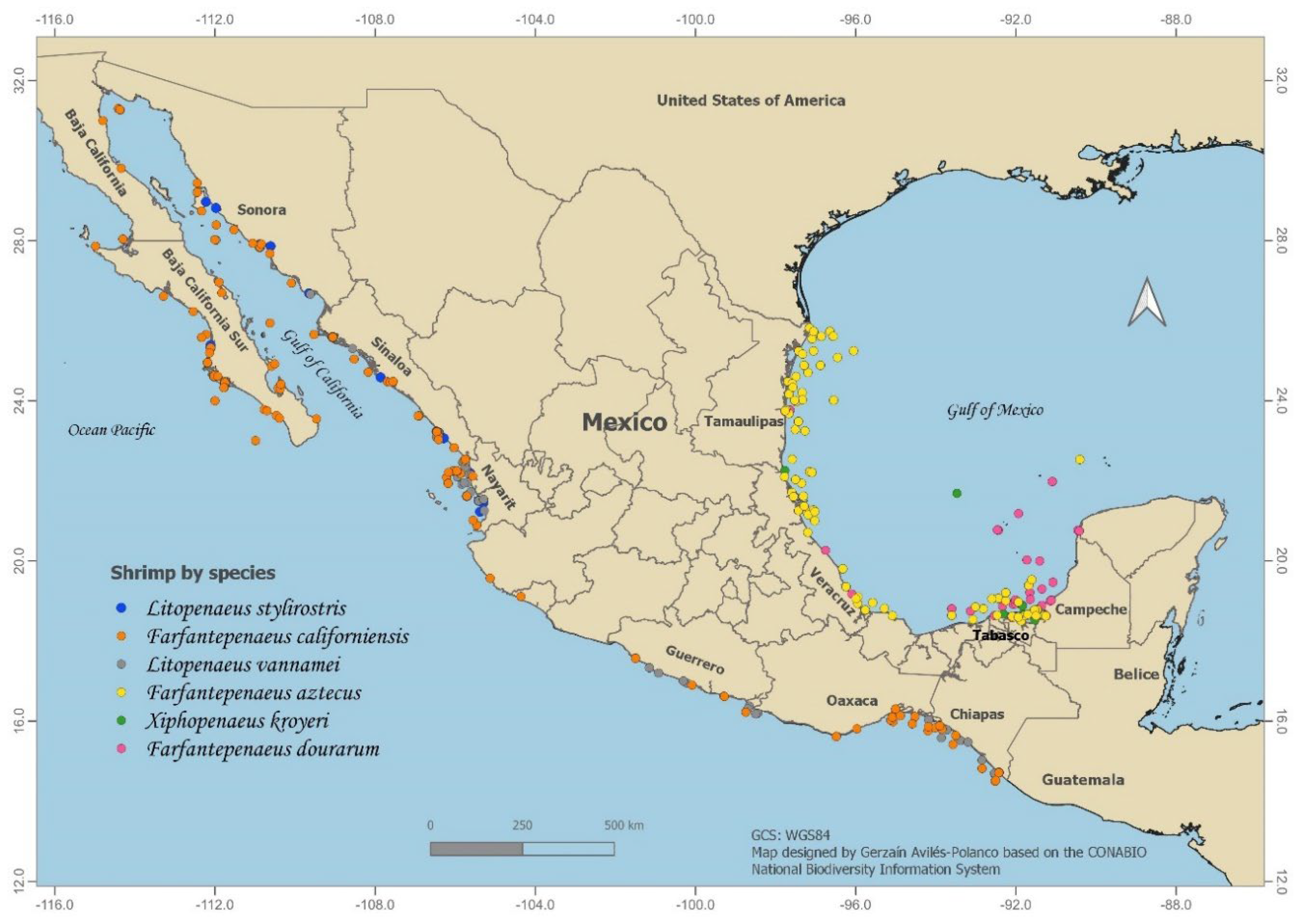

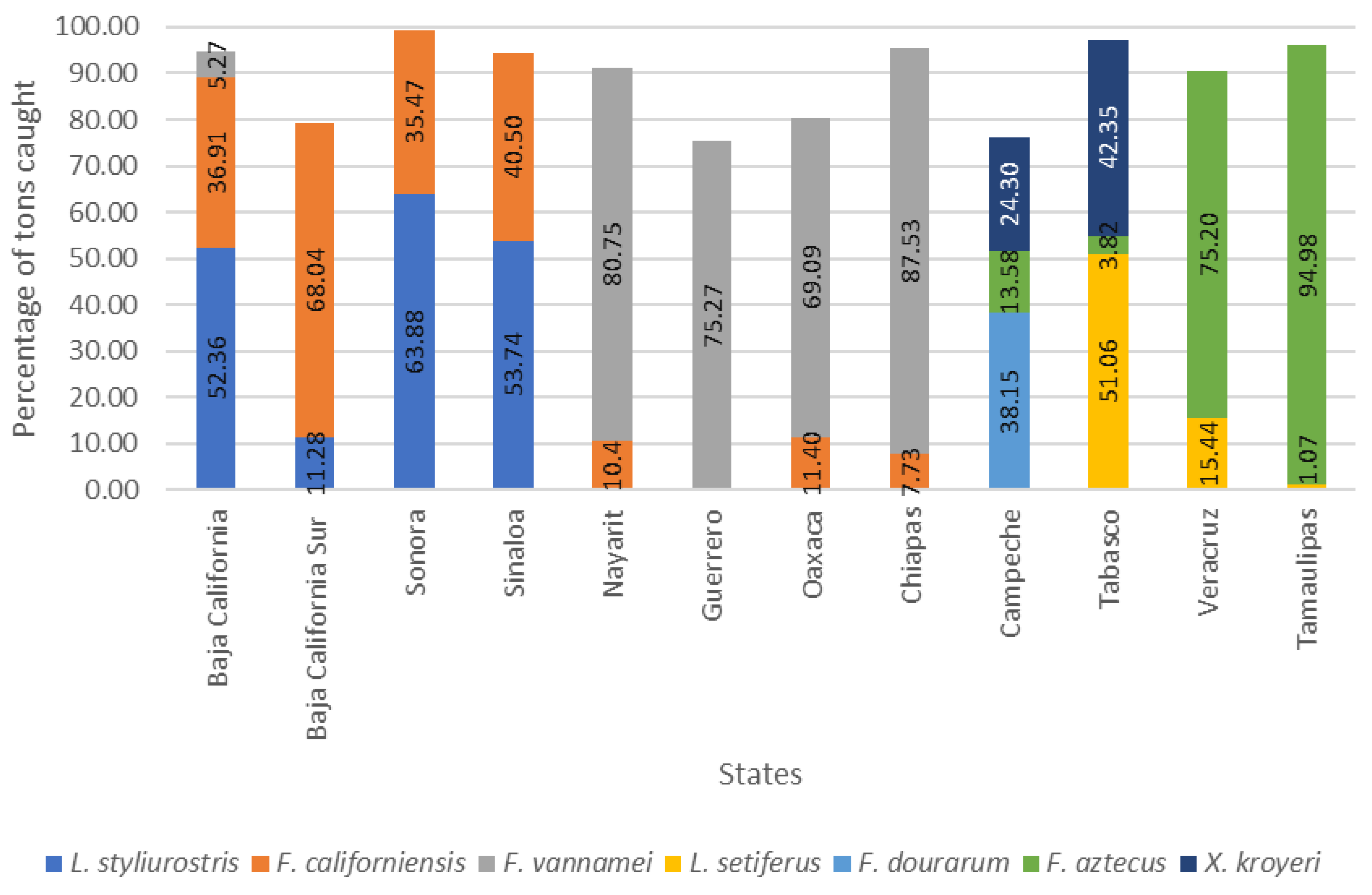
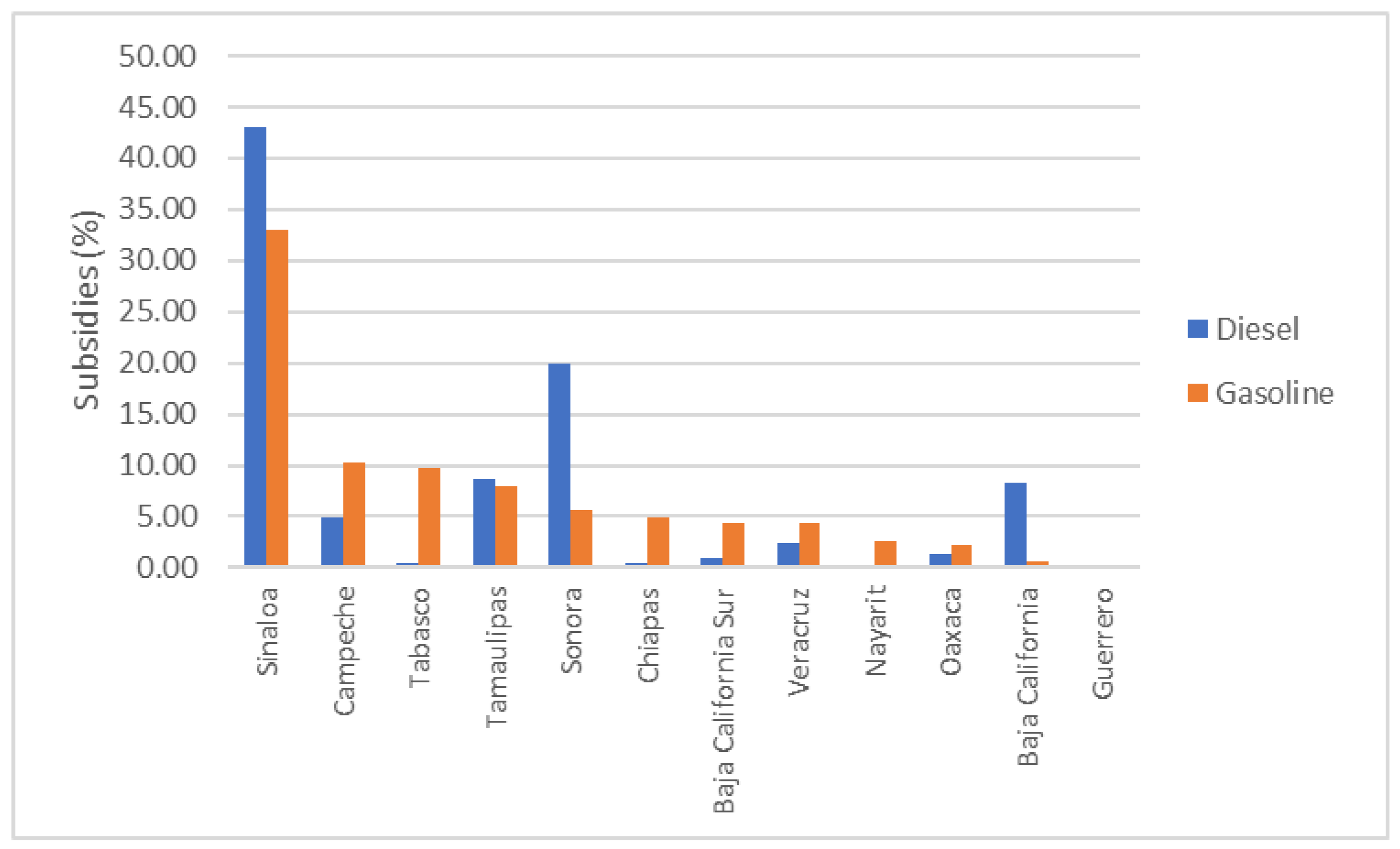

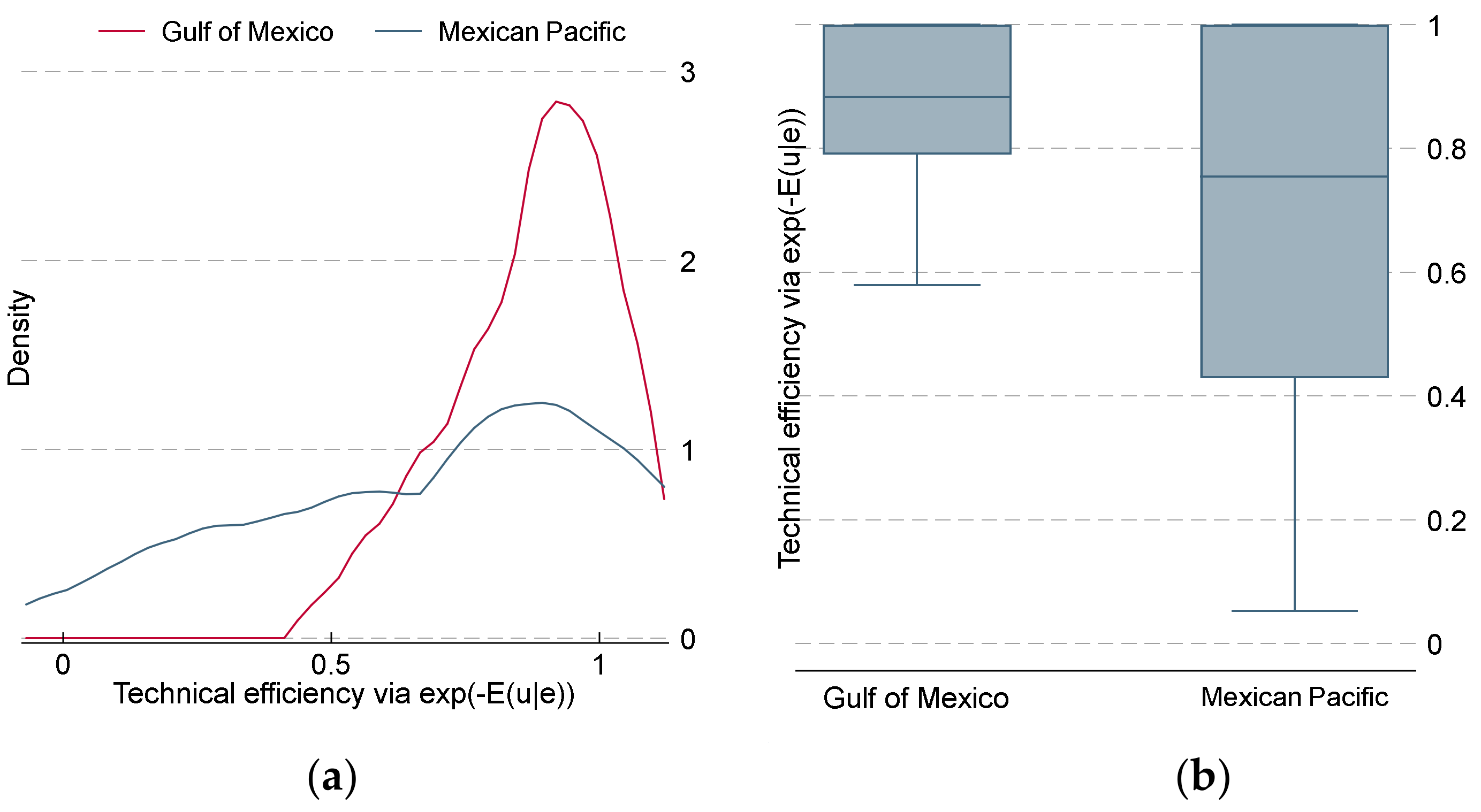
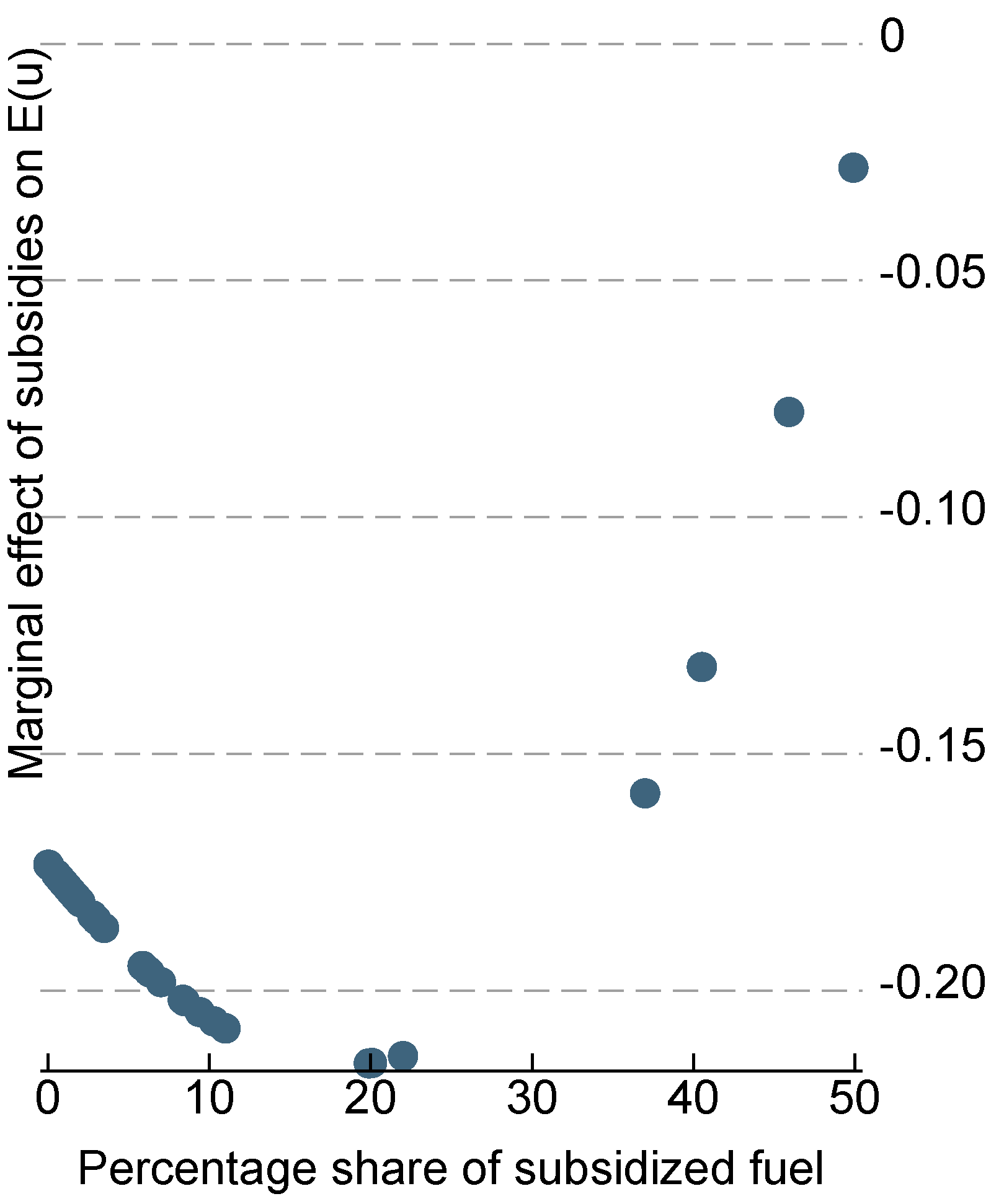
| State | 2003 | 2008 | 2013 | 2018 | ||||
|---|---|---|---|---|---|---|---|---|
| Companies | Catches (%) | Companies | Catches (%) | Companies | Catches (%) | Companies | Catches (%) | |
| Baja California (MP) | 24 | 1.0 | 16 | 1.3 | 12 | 1.2 | 9 | 0.2 |
| Baja California Sur (MP) | 14 | 1.1 | 22 | 1.6 | 36 | 1.5 | 40 | 2.2 |
| Campeche (GM) | 97 | 3.8 | 72.5 | 4.8 | 48 | 6.6 | 40 | 6.7 |
| Chiapas (MP) | 398 | 0.4 | 382.5 | 2.9 | 367 | 2.9 | 314 | 1.5 |
| Guerrero (MP) | 211 | 0.0 | 159 | 0.1 | 198 | 0.0 | 167 | 0.2 |
| Nayarit (MP) | 515 | 1.4 | 574 | 7.8 | 603 | 8.0 | 424 | 10.9 |
| Oaxaca (MP) | 420 | 1.2 | 427 | 2.0 | 514 | 3.7 | 931 | 2.4 |
| Sinaloa (MP) | 1025 | 37.3 | 1003 | 35.0 | 1147 | 46.7 | 933 | 36.7 |
| Sonora (MP) | 437 | 36.2 | 383 | 23.2 | 338 | 16.5 | 418 | 17.1 |
| Tabasco (GM) | 508 | 0.2 | 151 | 0.4 | 217 | 0.3 | 252 | 0.2 |
| Tamaulipas (GM) | 133 | 17.0 | 119 | 17.8 | 75 | 9.8 | 93 | 18.4 |
| Veracruz (GM) | 769 | 0.5 | 663 | 3.0 | 212 | 2.9 | 241 | 3.4 |
| Total | 4551 | 100% | 3972 | 100% | 3767 | 100% | 3862 | 100% |
| Variable | Description | Unit |
|---|---|---|
| Shrimp catch, live weight | Tons | |
| Cost per ton of shrimp | $ MXN | |
| Labor price per ton of shrimp | $ MXN | |
| Capital price per ton of shrimp | $ MXN | |
| Fuel price per ton of shrimp | $ MXN | |
| Natural log of shrimp catch, live weight | Log | |
| Natural log of cost per ton of shrimp | Log | |
| Natural log of labor price per ton of shrimp | Log | |
| Natural log of capital price per ton of shrimp | Log | |
| Natural log of fuel price per ton of shrimp | ||
| Normalized cost per ton of shrimp (cost/capital price) | Log | |
| Normalized labor price (labor price/capital price) | Log | |
| Normalized fuel price (fuel price/capital price) | Log | |
| Liters of fuel subsidized to shrimp fishing companies by state | Percentage share |
| Variable | Mean | Std. Dev. | Min. | Max. | Obs. |
|---|---|---|---|---|---|
| 5841.83 | 8460.44 | 0 | 31,314.12 | 48 | |
| 106,854.6 | 547,000.5 | 6.80 | 3,562,052 | 42 | |
| 73,996.66 | 386,858.1 | 759.88 | 2,518,768.0 | 42 | |
| 10,876.15 | 66,465.12 | 0.00 | 431,301.0 | 42 | |
| 27,056.89 | 108,369.6 | 2.38 | 704,702.2 | 42 | |
| 7.48 | 1.94 | 0.43 | 10.35 | 42 | |
| 7.43 | 3.69 | 1.92 | 15.08 | 42 | |
| 9.06 | 1.46 | 6.63 | 14.74 | 42 | |
| 3.64 | 3.85 | −6.488 | 12.97 | 42 | |
| 6.65 | 3.60 | 0.87 | 13.46 | 42 | |
| −0.28 | 18.44 | −95.31 | 53.71 | 42 | |
| −2.90 | 45.99 | −234.81 | 123.91 | 42 | |
| −0.08 | 16.04 | −81.86 | 48.80 | 42 | |
| 8.33 | 12.18 | 2 | 50 | 48 |
| Pooled | 1st Step FE Kumbhakar et al. [8] | 2nd Step Kumbhakar et al. [8] | 3rd Step Kumbhakar et al. [8] | ||
|---|---|---|---|---|---|
| Shrimp catch: | −0.04 | −0.11 *** | −0.05 | ||
| (0.03) | (0.00001) | (0.03) | |||
| Normalized fuel price: | 0.97 *** | 0.75 *** | 0.96 *** | ||
| (0.03) | (0.000004) | (0.03) | |||
| Normalized labor price: | 0.06 *** | 0.13 *** | 0.07 *** | ||
| (0.01) | (0.000001) | (0.01) | |||
| Year | 0.01 | 0.02 *** | 0.02 ** | ||
| (0.01) | (0.00005) | (0.01) | |||
| Constant | −21.35 | −40.82 ** | 3.38 × 10−18 *** | 0.31 *** | |
| (20.11) | (20.41) | (7.49 × 10−19) | (0.08) | ||
| −1.08 *** | |||||
| (0.31) | |||||
| 0.09 *** | −80.5 | −1.85 *** | |||
| (0.01) | (0.50) | ||||
| −32.85 | −81.95 *** | −2.82 *** | |||
| (228.85) | (0.63) | (0.40) | |||
| 0.43 | 1.9 | 3.32 × 10−18 | 0.40 | ||
| 0.22 | 7.00 × 10−8 | 1.6 × 10−18 | 0.24 | ||
| 2.00 | 2.08 | 1.621424 | |||
| 0.79 | 0.99 | 0.81 | 0.74 | ||
| Log-likelihood | −13.42 | −5.11 | 1657.64 | −13.99 | |
| 3.63 | 3.84 × 1012 | 13.64 | |||
| 0.03 | 0.00 | 0.00 |
| Efficiency Scores | Pooled | TFE | Kumbhakar et al. [8] |
|---|---|---|---|
| Overall | Transient | Time-Varying | |
| Mean | 0.64 | 0.75 | 0.69 |
| Std. Dev. | 0.31 | 0.29 | 0.19 |
| Min. | 0.03 | 0.05 | −0.08 |
| Max. | 0.99 | 0.99 | 0.92 |
| Variable | Mean | Std. Dev. | Min. | Max. |
|---|---|---|---|---|
| −0.17 | 0.04 | −0.21 | −0.03 | |
| −0.10 | 0.20 | −0.30 | 0.75 |
Disclaimer/Publisher’s Note: The statements, opinions and data contained in all publications are solely those of the individual author(s) and contributor(s) and not of MDPI and/or the editor(s). MDPI and/or the editor(s) disclaim responsibility for any injury to people or property resulting from any ideas, methods, instructions or products referred to in the content. |
© 2023 by the authors. Licensee MDPI, Basel, Switzerland. This article is an open access article distributed under the terms and conditions of the Creative Commons Attribution (CC BY) license (https://creativecommons.org/licenses/by/4.0/).
Share and Cite
Avilés-Polanco, G.; Almendarez-Hernández, M.A.; Beltrán-Morales, L.F.; Aranceta-Garza, F. Cost Efficiencies of the Shrimp Fishery in Mexico: A Stochastic Frontier Analysis. Fishes 2023, 8, 472. https://doi.org/10.3390/fishes8090472
Avilés-Polanco G, Almendarez-Hernández MA, Beltrán-Morales LF, Aranceta-Garza F. Cost Efficiencies of the Shrimp Fishery in Mexico: A Stochastic Frontier Analysis. Fishes. 2023; 8(9):472. https://doi.org/10.3390/fishes8090472
Chicago/Turabian StyleAvilés-Polanco, Gerzaín, Marco Antonio Almendarez-Hernández, Luis Felipe Beltrán-Morales, and Fernando Aranceta-Garza. 2023. "Cost Efficiencies of the Shrimp Fishery in Mexico: A Stochastic Frontier Analysis" Fishes 8, no. 9: 472. https://doi.org/10.3390/fishes8090472
APA StyleAvilés-Polanco, G., Almendarez-Hernández, M. A., Beltrán-Morales, L. F., & Aranceta-Garza, F. (2023). Cost Efficiencies of the Shrimp Fishery in Mexico: A Stochastic Frontier Analysis. Fishes, 8(9), 472. https://doi.org/10.3390/fishes8090472






